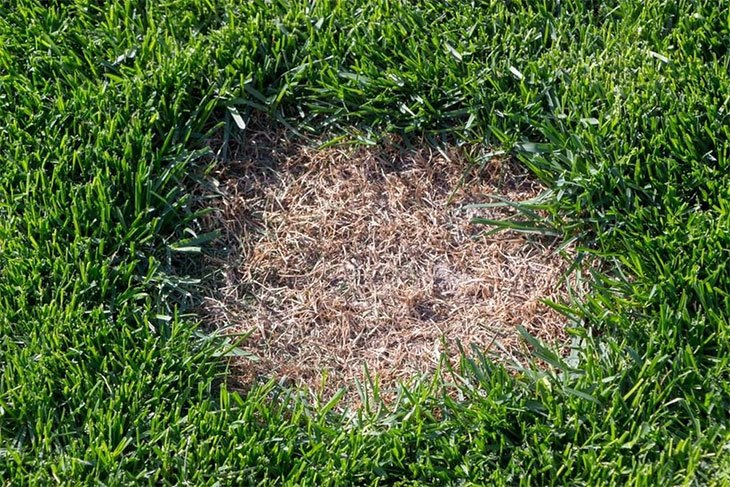Well-manicured grasses leave your yard looking neat and clean. But a lot of effort goes into this. One, you must water the lawn to give the grass enough juice for growth. Second, trimming is mandatory to enhance quality development.
In brief, the beauty of the garden lies in the amount of effort you put in. But that does not mean it is always a smooth sail. Grasses suffer from an unusual illness called the lawn rust disease. It is unlike anything you have ever seen because it discolors infected blades, making them dry to a pulp.
Causative Agents

Bluegrass and ryegrass are the most affected. The rust, although cosmetic, alters the “greenness” of the grass blades, giving them a distinct orange appearance. But what causes the lawn rust disease?
According to scientists, the fungal disease affects turf grasses with stunted growth. Besides, the herbs are susceptible to fungal attacks in the late summer or early fall. Low nitrogen levels also amplify the condition.
The Signs and Symptoms
How can you detect lawn rust? It’s simple. The disease manifests in the form of yellow dots on the grass blades. These patches, however, become bolder and longer with time and are easy to spot from a mile away.
They then rapture on maturity and release the orange-looking powder on the leaf blade. The grasses, however, appear shredded as the condition worsens. Affected vegetation then becomes prone to other lawn diseases, and might suffer throughout its lifespan if nothing gets done, and soon.
Effects

Grasses affected by lawn rust are prone to:
- A series of health-related complications
- Stunted growth
- Structural weakness
- Irritable stains
- A reduction in their ability to photosynthesize
Prevention and Cure
Therefore, how do i get rid of rust in my lawn? Below is a to-do-list that guarantees you a lifetime cure!
1. Fertilize the Yard
Lawn rust forms because of nitrogen content alterations. It is, therefore, vital that you nourish the yard with small amounts of slow-release nitrogen fertilizer throughout the growing season. Applications should, however, happen every six weeks.
It is also best that you concentrate on the affected areas. Using nitrogen-based fertilizers is, anyhow, unnecessary during the fall. Recall, a product overdose paves the way for more fungal attacks.
2. Water When It Matters

Grasses suffer from the lawn rust disease when there are imbalances in temperature and humidity levels. Curbing the nuisance is, thus, possible when you water the lawn in the morning. Watering is useful, given that it protects the grasses from the damaging effects of heat stress.
Doing so before dawn helps the cause. Remember, plants watered early in the morning have more than enough drying-time during the day. But there is a catch. You should only water the vegetation down two to three times a week.
3. Groom the Yard Regularly
You should make lawn grooming a routine, and here is why. Cutting the blades helps remove sections affected by lawn rust. The result is a network of plants with proper air circulation. But you should not just use any mower that comes your way.
Instead, focus on getting a standard machine with a grass catcher. The catcher traps grass cuttings. It also reduces the chances of healthier grasses getting contaminated by the rust significantly.
Last, you must clean the equipment after use. Sterilization eliminates rust dust that might otherwise spill on the lawn during future grooming exercises. It’s as simple as that!
4. The Use of Chemical Methods
Chemicals are not that good for your yard or garden. But they come in handy when other techniques fail. All you must do is book an appointment with the landscaping experts. Recall, it is only the landscapers only who have access to the best fungicides in town.
The experts can, therefore, buy Strobilurin and the DeMethylation inhibitor, two superior herbicides for you. These products are perfect, given they contain the rust with only a single application. They are that good! Herbal administration must, however, get done before winter.

Conclusion
Lawn rust does not kill the plant. It only makes grasses weak and prone to other fungal attacks. Besides, it makes your yard unsightly, which is why you must curb the menace. But how do you accomplish the task without spending a lot of money?
One, you can rely on non-chemical elimination methods. Introducing nitrogenous fertilizers, for instance, improves the quality of the grass. It also prevents the plants from developing lawn rust in the future. Regular watering and grooming also help the cause.
But then, there are chemical techniques you cannot ignore. Fungicides eliminate the lawn rust disease when all other options have failed.
Chemicals, being more intrusive, must get administered by a certified gardener or landscaper. But overall, the lawn rust disease is manageable.
Leave a Reply